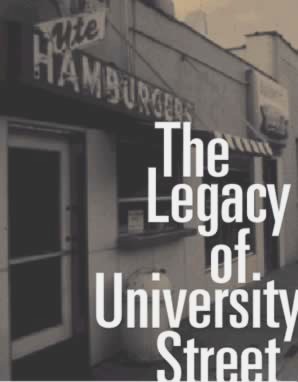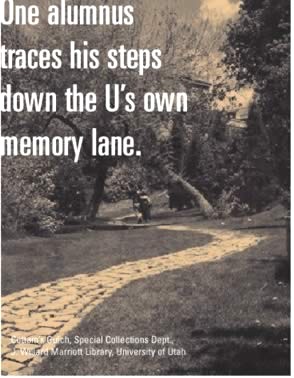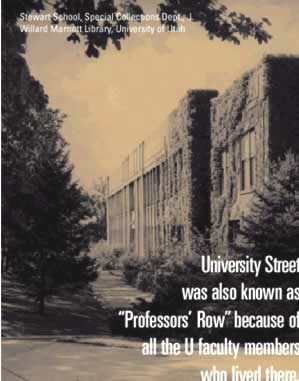
 hen I was young we
lived in my grandfather’s basement at 248 University Street, just
across the street from the University of Utah. My grandfather, Angus M.
Woodbury, a biology professor at the U, loved to take me for walks. Every
so often he would steal me away from my mother and we would stroll hand
in hand up University Street to Ute Hamburger.
hen I was young we
lived in my grandfather’s basement at 248 University Street, just
across the street from the University of Utah. My grandfather, Angus M.
Woodbury, a biology professor at the U, loved to take me for walks. Every
so often he would steal me away from my mother and we would stroll hand
in hand up University Street to Ute Hamburger. Located where Big Ed’s is now, Ute Hamburger was an exciting place for a towheaded youngster. I can remember climbing up on one of the stools at the counter and watching, with wide-eyed amazement, as Sherm Fisher, the owner, cook, and chief bottle washer, stood at the grill frying hash browns and burgers. Sherm’s hash browns were something special. Much later I learned it was his secret recipe that made them the best in town, but all I knew then was that they were better than anything this kid had ever eaten. I loved watching Sherm cook. His spatula flew over the grill flipping burgers, turning hash browns, and frying eggs, while he kept up a non-stop conversation with the customers. The memory of Sherm standing at that grill is still etched in my mind and ever since then I’ve harbored a secret desire to be a fry cook.
 University
Street was more than just Ute Hamburger. Running from 5th South to South
Temple (where it becomesVirginia Street and heads into Federal Heights),
it was also known as “Professors’ Row” because of all the
U faculty members who lived there, including John Baliff, E.E. Ericksen,
LeRoy Taylor, and Walter Kerr. Two former University presidents, George
Thomas and LeRoy Cowles (pronounced Coals), also made their homes on the
street. It was a short walk from anywhere on the street to campus, which,
for many years, ended at the Park Building.
University
Street was more than just Ute Hamburger. Running from 5th South to South
Temple (where it becomesVirginia Street and heads into Federal Heights),
it was also known as “Professors’ Row” because of all the
U faculty members who lived there, including John Baliff, E.E. Ericksen,
LeRoy Taylor, and Walter Kerr. Two former University presidents, George
Thomas and LeRoy Cowles (pronounced Coals), also made their homes on the
street. It was a short walk from anywhere on the street to campus, which,
for many years, ended at the Park Building.
The professors who lived on University Street were a close-knit group.
Not only were they together every day on campus, they also got together
socially. Many of them were members of a dinner group called “The
Neighborly Circle” that met once a month. Several of the University
Street residents also owned cabins in an area called “The Firs,”
located at the top of Millcreek Canyon.
It was a great street on which to grow up. Children who lived on University
Street attended Stewart School, an elementary and secondary school where
U of U students received teaching training and experience. The building,
on the east side of University Street, is still there, although it is
now home to the anthropology department. My uncle, J. Walter Woodbury
BS’43 MS’47 PhD’50, a retired U professor of physiology
who now lives in my grandparents’ house, attended Stewart School.
“From kindergarten through college, my education took place on the
U campus, except for the two years I spent at East High School,”
he remembers. “They had great teachers at Stewart School. The idea
was to assemble the best group of teachers they could find to teach at
the school and then let the University students train under them.”
 Because
they lived so close, many Stewart students would go home for lunch every
day. However, the few with a little money would head to Ute Hamburger
for the noon meal. Neil Hancey BS’59, who was with the Alumni Association
for many years, spent his college days working at Ute Hamburger. Hancey,
now retired and living in Hawaii, remembers that lunch time was a zoo.
“All the kids from Stewart School came over. Since all those kids
ever wanted was the lunch special—two burgers and a drink for 50
cents—we’d fry up a bunch of hamburgers in advance, wrap them
in waxed paper, and just stand back. Sherm made the Stewart kids stay
outside and one of the waitresses served them through the walk-up window,”
Hancey recalls.
Because
they lived so close, many Stewart students would go home for lunch every
day. However, the few with a little money would head to Ute Hamburger
for the noon meal. Neil Hancey BS’59, who was with the Alumni Association
for many years, spent his college days working at Ute Hamburger. Hancey,
now retired and living in Hawaii, remembers that lunch time was a zoo.
“All the kids from Stewart School came over. Since all those kids
ever wanted was the lunch special—two burgers and a drink for 50
cents—we’d fry up a bunch of hamburgers in advance, wrap them
in waxed paper, and just stand back. Sherm made the Stewart kids stay
outside and one of the waitresses served them through the walk-up window,”
Hancey recalls.
But it was U
students and faculty members who were the bread and butter of this campus
hangout. “The menu was always simple,” remembers Hancey, “breakfast,
lunch, supper—hamburgers, eggs, and the best hash browns in Salt
Lake City. The Ute Special, a hamburger with a fried egg on it, was about
as fancy as it got. The big rushes were breakfast and lunch. In the morning,
diners could get two eggs, hash browns, toast, and all the coffee they
could drink for 75 cents. You could only get Coke, root beer, 7-up, or
coffee to drink.” Hancey says they did keep a stash of teas for the
shoemaker who owned the shop next door and for Stephen Durrant BA’29
MA’31, a biology professor who taught premed students. Durrant came
in almost every day but never ordered anything to eat. He just sat there,
drank tea, and observed the customers.
 Ute Hamburger
was also a popular place for U athletes to eat. One football player used
to come in every morning for—if you can believe this—a raw hamburger
seasoned with salt and pepper. One morning Durrant was drinking his tea
when the player came in, unshaven, dressed in a ripped t-shirt, and barefoot.
He grunted for his breakfast and Sherm flipped him his raw patty. He put
a little salt and pepper on it, ate it, and left. Durrant, a dignified
buttoned-down sort, stared, mouth agape, as the player walked out the
door. “Sherm, do you realize what we have just seen here?” said
Durrant. “I think that was the missing link.” The restaurant
erupted in laughter.
Ute Hamburger
was also a popular place for U athletes to eat. One football player used
to come in every morning for—if you can believe this—a raw hamburger
seasoned with salt and pepper. One morning Durrant was drinking his tea
when the player came in, unshaven, dressed in a ripped t-shirt, and barefoot.
He grunted for his breakfast and Sherm flipped him his raw patty. He put
a little salt and pepper on it, ate it, and left. Durrant, a dignified
buttoned-down sort, stared, mouth agape, as the player walked out the
door. “Sherm, do you realize what we have just seen here?” said
Durrant. “I think that was the missing link.” The restaurant
erupted in laughter.
Ute Hamburger was not the only place to “dine” on University
Street. There was also the College Inn, locatedon the corner of 200 South.
Bill Marcroft BFA’52, the “Voice of the Utes” on KALL Radio
for the last 30 years, attended the University in the mid-1950s and hung
out at the “CI.” “One of the things I really miss from
my college days is the College Inn,” says Marcroft. “The Union
building used to be where Gardner Hall is now, but there wasn’t much
to do there, and nobody I knew ever went there. Everyone used to stop
after every class at the CI. There was a long counter as you came in and
in the back were tables and booths.”
 Marcroft
remembers the College Inn as having the worst food ever. “Ute Hamburger
had much better food,” says Marcroft, “but they had no booths,
so everyone I hung with went to the CI.” There were pinball machines
located in the College Inn, but Marcroft remembers some other activities
that took place there as well. “It was so dark back where the booths
were I think a lot of people learned about life back there. I know I did.
I had my first cup of coffee in the back of the College Inn.”
Marcroft
remembers the College Inn as having the worst food ever. “Ute Hamburger
had much better food,” says Marcroft, “but they had no booths,
so everyone I hung with went to the CI.” There were pinball machines
located in the College Inn, but Marcroft remembers some other activities
that took place there as well. “It was so dark back where the booths
were I think a lot of people learned about life back there. I know I did.
I had my first cup of coffee in the back of the College Inn.”
Danny Hawes BS’68, a former Ute basketball player and now the assistant
director of the Crimson Club for the U of U Athletics Department, remembers
University Street for another significant event. “I was walking down
University Street with my girlfriend (now my wife). We had just come from
an Institute class [the old LDS Institute was located on the corner of
University Street and 300 South] when one of my friends drove by in a
car and yelled out the window that President Kennedy had just been shot.
We raced over to the Sigma Chi house and watched the events unfold on
their little black-and-white TV for the rest of the weekend.”
 At the
south end of University Street was Carlson Hall, then the women’s
dormitory and now the home of the history department. Needless to say,
traffic on that part of the street was heavy. Groups of students who lived
in nearby apartments were always taking shortcuts across people’s
lawns. So many students cut across one man’s lawn that they wore
an “X” in the grass. He finally got fed up, pulled up his front
lawn, and replaced it with concrete — painted green.
At the
south end of University Street was Carlson Hall, then the women’s
dormitory and now the home of the history department. Needless to say,
traffic on that part of the street was heavy. Groups of students who lived
in nearby apartments were always taking shortcuts across people’s
lawns. So many students cut across one man’s lawn that they wore
an “X” in the grass. He finally got fed up, pulled up his front
lawn, and replaced it with concrete — painted green.
University Street has changed a lot over the years. Now, only residents
can park there. No more pulling into an empty parking place and running
across the street to class unless you want a parking ticket. Big Ed’s
has replaced Ute Hamburger as the landmark hangout. The tennis courts,
where the great Tony Trabert used to play doubles with Bill Marcroft and
his wife, are still there, as is the law school and Simmons Pioneer Memorial
Theatre. The south section of the street still ends at the stadium parking
lot, but that part of the lot is now a TRAX station. Students still walk
through Cottam’s Gulch (formerly called The Gulley when my uncle
played football in it), and lying on the grassy hill on a sunny spring
day is still a good way to study or grab 40 winks.
The one thing University Street still brings back for everyone who has
driven it, walked it, or called it home is a truckload of memories—memories
that were made on the street where U lived.
—Bruce D. Woodbury BS’72 is director of community relations
for U of U Athletics.
